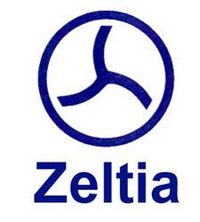Zeltia facts for kids
 |
|
| Sociedad Anónima | |
| Traded as | BMAD: ZEL |
| ISIN | ISIN: [https://isin.toolforge.org/?language=en&isin=ES0184940817 ES0184940817] |
| Industry | Pharmaceutical |
| Founded | Vigo, Galicia, Spain (August 3, 1939) |
| Defunct | 2015 |
| Headquarters |
Madrid
,
Spain
|
|
Area served
|
Worldwide |
|
Key people
|
José Fernández Sousa-Faro (Chairman) |
| Products | Pharmaceuticals |
| Revenue | |
|
Operating income
|
|
| Total assets | |
| Total equity | |
| Subsidiaries | PharmaMar, Genómica, Sylentis, Zelnova, Xylazel |
Zeltia was a Spanish company that worked in the world of medicines and chemicals. It had many smaller companies, called subsidiaries, that focused on different areas like making medicines or special chemicals. Zeltia was known for its research, trying to find new and important medical products.
Contents
A Look Back at Zeltia's Journey
Zeltia started a long time ago, in 1939, in a city called Vigo in Spain. It grew out of another laboratory called Miguel Servet. The Fernández López brothers from Lugo were the main people who helped start it.
Early Days and Scientific Help
At the beginning, a scientist named Fernando Calvet Prats helped Zeltia a lot. He came from the University of Santiago. He had faced difficulties because of the government at the time. Calvet shared his scientific knowledge with the company until he went back to the University of Salamanca in 1944.
What Zeltia Aimed to Do
The first goal of Zeltia was to use medicinal plants found in Spain. They also wanted to use products from animal glands, which they got from meat companies. The Fernández López brothers worked with these meat companies through slaughterhouses in Porriño and Mérida.
Key People in Zeltia's Founding
Fernando Calvet had worked as a technical director at Miguel Servet Laboratories in Vigo. His job was to set up a lab to study how to get special substances from rye. These substances were used to make a medicine called "Pan-Ergot," which helped with headaches and an eye condition called glaucoma. The director of Miguel Servet was Dr. Obella Vidal.
When a civil war started, Calvet went to Sweden. Dr. Obella Vidal registered a brand name called Zeltia in Portugal in August 1937. This was for using the rye substances. He also got permission to grow medicinal plants in the Porriño area, where the Fernández López brothers had many of their businesses.
Once an agreement was made, Calvet returned to Spain and continued his work at the company. The ownership of Zeltia showed how important each person was. The four Fernández López brothers each had 200 shares. Dr. Obella Vidal also had 200 shares. José Ruiz and Fernando Calvet Prats each had 25 shares, and Fidel Isla Couto had 10 shares.
Changes Over the Years
In 1993, Zeltia sold one of its smaller companies, Cooper-Zeltia. This company later changed its name to Zendal.
Later, Zeltia itself was taken over by one of its own smaller companies, Pharma Mar. This is called a "reverse takeover." Even though Pharma Mar took over, the overall structure of the Zeltia Group stayed the same.
In 2018, Pharma Mar sold Xylazel to a Dutch company called AkzoNobel. Then, in 2019, Pharma Mar sold Zelnova, which was the last Zeltia Group company in Galicia. It was sold to a Spanish investment company for 33 million euros.
Zeltia's Subsidiary Companies
A subsidiary is a company that is owned or controlled by another larger company. In 2009, Zeltia had several direct subsidiaries. These included:
- Pharma Mar, S.A.U.
- Genómica, S.A.U.
- Zelnova, S.A.
- Protección de Maderas, S.A.U.
- Xylazel, S.A.
- Noscira, S.A.
- Sylentis, S.A.
Some companies were indirect subsidiaries, meaning they were owned by one of Zeltia's direct subsidiaries. For example, Pharma Mar had its own subsidiaries like Pharma Mar US and Pharma Mar GmbH. Also, Zelnova had one direct subsidiary called Copyr, S.p.A.
See also
 In Spanish: Zeltia para niños
In Spanish: Zeltia para niños

